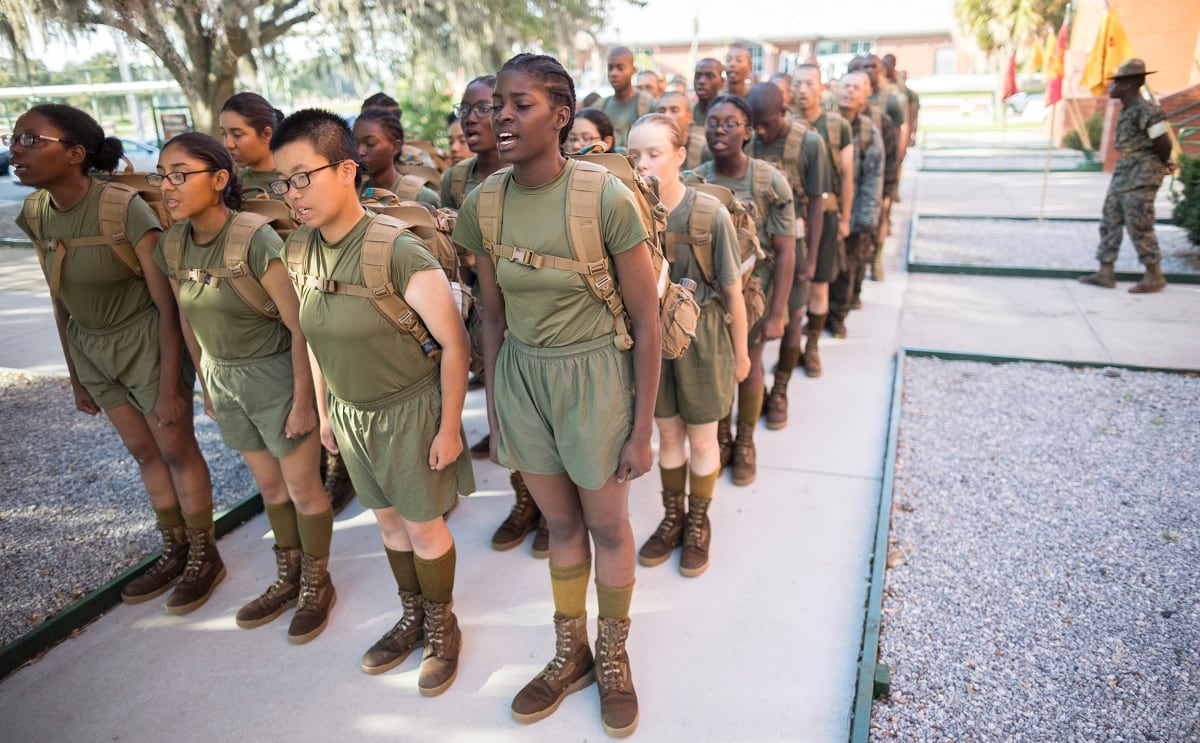Not long ago, Marine Col. Jennifer Nash, a combat engineer with war deployments under her belt, made a vow to fellow officers as they headed to a dinner in Atlanta: She would get two new recruiting contacts by the end of the evening.
She admits recruiting is not the job that she or other Marines had in mind when they enlisted. But after stints as a recruiter and senior officer at the Eastern recruiting command, she has become emblematic of the Corps’ tradition of putting its best, battle-tested Marines on enlistment duty. They get results.
Marine leaders say the Corps will make its recruiting goal this year, while the active-duty Army, Navy and Air Force all expect to fall short. The services have struggled in the tight job market to compete with higher-paying businesses for the dwindling number of young people who can meet the military’s physical, mental and moral standards.
On that night, Nash achieved her own goal. She had gotten the valet at the hotel and the hostess at the restaurant to provide their phone numbers and to consider a Marine career.
Nash’s boss, Brig. Gen. Walker Field, who heads the Eastern recruiting region, says the Corps historically has put an emphasis on selecting top-performing Marines to fill recruiting jobs. He says that has been a key to the Marines’ recruiting success, along with efforts to increase the number of recruiters, extend those who do well and speed their return to high schools, where in-person recruiting stopped during the COVID-19 pandemic.
He said his recruiters — who cover the territory between Canada and Puerto Rico and as far west as Mississippi — will meet their mission and expect to have 30% of their 2024 goal when they start the next fiscal year, Oct. 1. More broadly, Marine officials say they expect the Corps to achieve its recruiting target of more than 33,000.
In 2022, the Navy, Air Force and Marines had to eat into their pools of delayed entry applicants in order to make their goals. The Marines will avoid that this year.
“That would be a great ending,” said Field, speaking to The Associated Press on a recent steamy day at South Carolina’s Parris Island, along the Atlantic Coast. “I’m bearish for not only concluding FY23 on a strong footing, but also how we set the conditions for FY24.”
The Marine Corps may get some help from its small size. The Army, for example, has a recruiting goal of 65,000 for 2023, which is nearly double the Corps’, and expects to fall substantially short of that. Air Force and Navy officials say they will also miss their goals, although the Space Force, which is the smallest service and does its recruiting within Air Force stations, is expected to meet its goal of about 500 recruits.
Sitting in the shadow of the Parris Island, South Carolina, replica of the Iwo Jima monument, Field said his biggest challenge is that a number of Marine hopefuls cannot pass the military’s academic test, known as the Armed Services Voluntary Aptitude Battery.
That is a widespread problem, but the Army recently set up a program that targets recruits who score below 30 on the test and provides schooling for several weeks to help them pass. Already more than 8,800 recruits have successfully gone through the classes, raised their scores and moved on to basic training.
The Navy is taking another route with a pilot program that allows up to 20% of its recruits to score below 30 on the test, as long as they meet specific standards for their chosen naval job. Marine leaders, however, do not take those lowest scoring recruits, and so far have no plans for any type of formal improvement program such as the Army’s.
Field said the Marines are repositioning recruiting stations, moving them around based on where population totals have increased in the latest census. More important, he said, the Corps maintains its focus on choosing the right recruiters, encouraging successful ones to stay in the job and increasing the number of Marine reservists tapped for recruit duties from the current 31 to 96 by the end of next year.
Nash, who until June was assistant chief of staff for the Eastern region, said Marines are hand-selected for recruiting command jobs. Many three- and four-star Marines, including former Defense Secretary James Mattis, will cite their years doing enlistment duty.
“We put our best and brightest in those positions,” said Nash, adding that those chosen for recruiting posts have a proven track record of success in previous assignments and have demonstrated critical leadership skills. “That’s why they got selected, because they were above their peers.”
She acknowledged that the first time she was picked for a recruiting job she was “voluntold.” But now, recounting her sales pitch in Atlanta, her rapid fire pitch comes without taking a breath.
“I say, ‘Hey, ever thought about being Marine? We’re a bunch of Marines. And, you know, I think you potentially could be a good Marine. You ever thought about it?’ And usually you get, ‘Yeah, I thought about it.’ And I’m, like, ‘What’s holding you back? Would you like to learn more about your opportunities?’ ‘Absolutely.’ `OK. Mind giving me your name and phone number? I’ll have one of my recruiters give you a phone call.’”
The Marines have resisted increasing bonuses to attract recruits — something the other services have found helpful.
Gen. Eric Smith, the acting Marine Corps commandant, got some ribbing for his response when he was asked about bonuses during a naval conference in February.
“Your bonus is you get to call yourself a Marine,” he said. “That’s your bonus, right? There’s no dollar amount that goes with that.”
Field, Nash and others also say the Corps prefers to give a lot of recruits a few thousand dollars, rather than increasing the amount and giving money to far fewer people.
Field said that getting Marine recruiters in uniform back into high schools this year, after several years of COVID-19 restrictions, has been a key driver. There, young people line up to compete in pull-up contests, vying for a free T-shirt if they can do 20. And recruiters say many are drawn to the cache of being a Marine.
“If you told me you’ll give me $10 million worth of advertising and I can do something with it, or you’ll give me 10 great-looking Marines in a Marine uniform — what’s going to get the most value? Give me those 10 Marines and give me a day,” Nash said. “We’ll go out and we’ll get more out of that, I think, than $10 million in advertising.”




